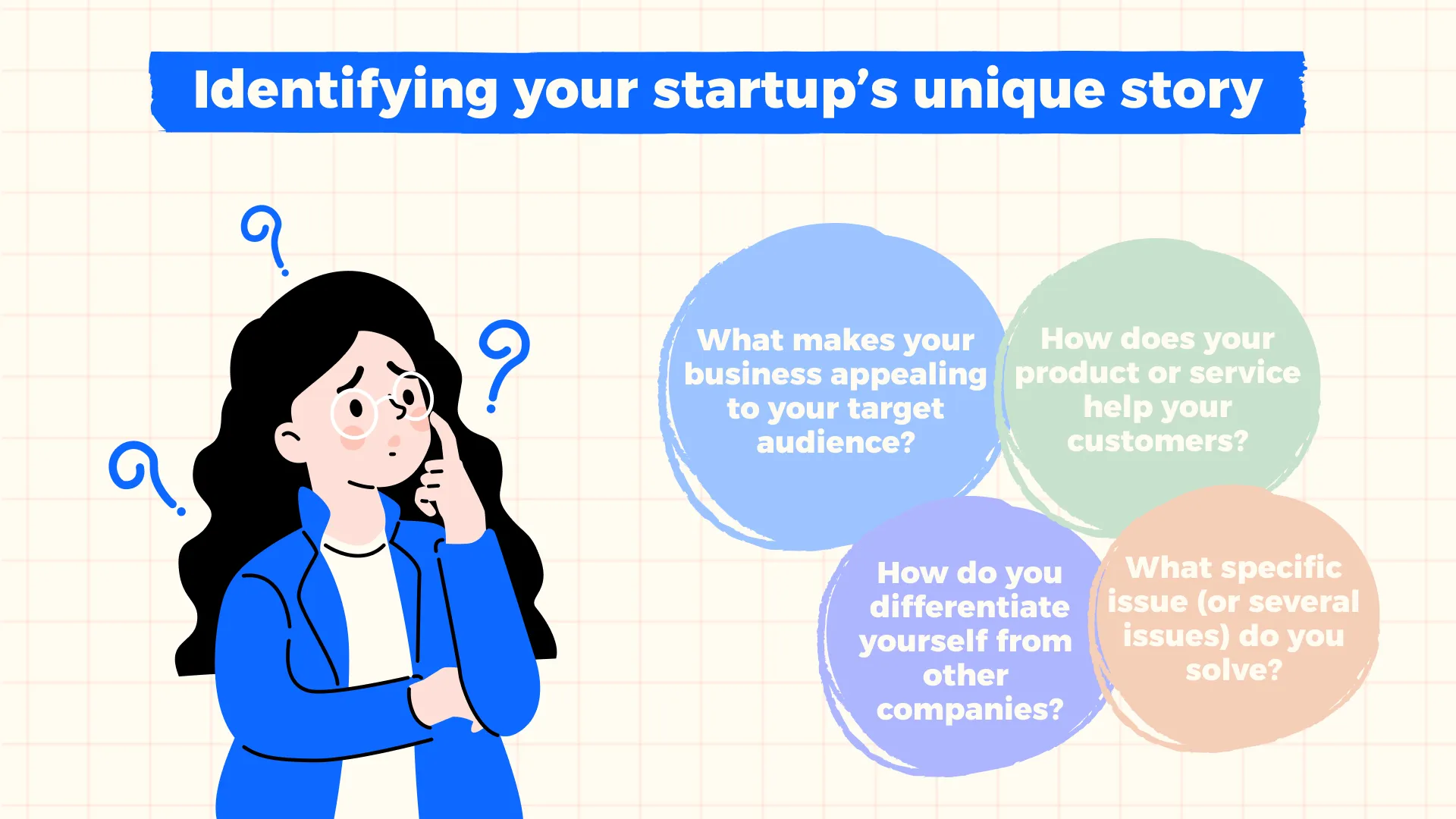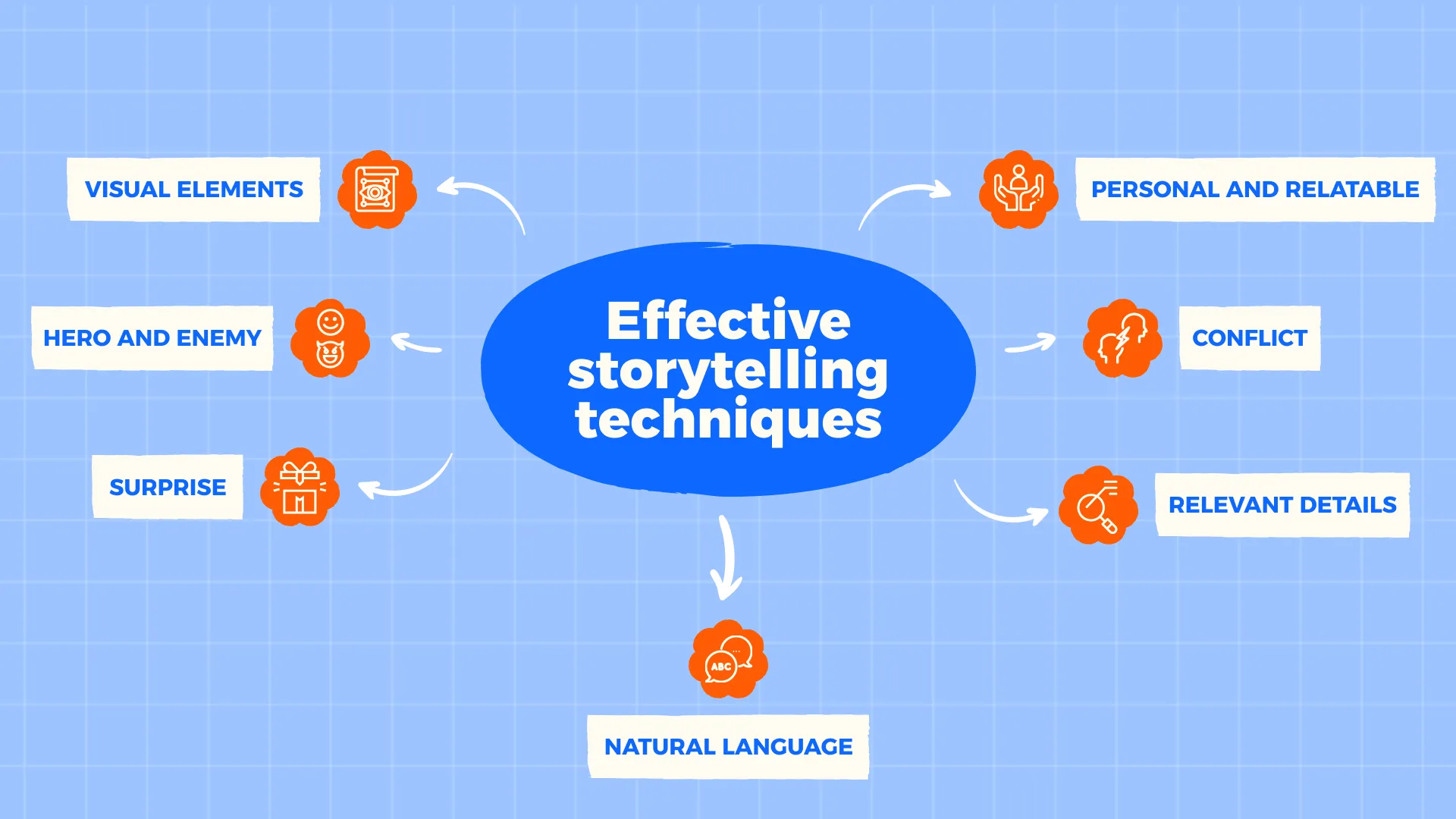
Storytelling in a Pitch Deck: Win the Investors’ Hearts
.webp)
A pitch deck is a brief presentation that provides an overview of your startup. It's used during pitching sessions to inform interested parties, such as investors or potential employees, about the key aspects of your startup.
When it comes to pitching to investors, the goal is to persuade them to invest in your startup. This involves using various techniques and strategies when creating pitch decks. Simply presenting facts and data won't cut it - it might even bore your audience. That's where storytelling comes in. It makes your pitch memorable, helps to evoke emotions, and shows empathy.
Let's learn more about the magical storytelling technique and find out how to use and improve storytelling in a pitch deck to line up with well-known enterprise presentation design services, shall we?
Understanding the Power of Storytelling in a Pitch Deck
Here at Whitepage, a presentation design company, we are convinced that the focus of a pitch deck isn't just about its existence; it's about the content it encompasses—whether that's data or storytelling. For startups seeking funding, this presents a significant challenge. While some prefer to populate their pitch decks with loads of numbers and intricate details to showcase their credibility, others opt for a more narrative approach.
If you're a startup that has dedicated a lot of time to your venture, it's only natural that you would want to present extensive data – from generated revenues to allocated capital for resources and customer acquisition, encapsulated within the framework of a compelling business model slide. This data is indeed important. After all, when you have credibility, why not demonstrate it through tangible figures?

However, despite the undeniable significance of data within a pitch deck, storytelling proves to be far more effective when pitching to venture capitalists (VCs). The primary reason is that it allows you to captivate the audience and foster an emotional connection.
By incorporating storytelling into your pitch deck, you embark on a journey that takes your potential investors along. This connection not only increases the likelihood of them investing in your company or product but also in your vision.
Here's why storytelling is essential when crafting your pitch deck:
- Tap into ancient wisdom: stories have been used throughout history to help us understand the world. By harnessing this timeless tradition, you can engage your audience and create a strong emotional connection.
- Build emotional bonds: stories can forge deep emotional connections uniquely. By weaving a compelling narrative, you can establish a strong bond with your investors, increasing their investment in your journey and success.
- Take investors on a journey: stories take your investors on an immersive journey. By guiding them through challenges and victories, you make them emotionally invested in your story, increasing their desire to be part of your success.
- Unforgettable impact: people remember stories more effectively than cold, hard facts. Incorporating storytelling into your pitch deck boosts the chances of your message resonating and staying with your audience long after the presentation.
Considering these reasons, it's no wonder many successful brands have embraced storytelling in their pitch decks. For instance, the Atlanta startup Kabbage used storytelling in its pitch deck, securing over $1.3 billion in investments as a result.
The Art of Crafting Your Startup's Story: Improve Storytelling in a Pitch Deck
Now, let's get practical: we have prepared a range of tips on how to use storytelling in pitch deck and make it as engaging as possible.
Identifying your startup’s unique story
First of all, you must have a clear understanding of who you are. Being yourself when telling your story is essential to connect with your audience. Here are some helpful questions:
- What makes your business appealing to your target audience?
- How does your product or service help your customers?
- How do you differentiate yourself from other companies?
- What specific issue (or several issues) do you solve?

By answering these questions, you can shape your messaging and present yourself in the best light.
A study by Motista, a company specializing in emotional connection research, showed that customers who feel emotionally connected to a brand are much more valuable. They are likely to spend double the amount compared to customers who are simply satisfied with the brand at the most basic level.
The elements of a compelling story
To make your pitch presentation stand out, we recommend considering the following elements:
- Start with a compelling introduction that highlights your vision;
- Present the problems your product or service solves and offer effective solutions;
- Identify market opportunities that demonstrate the potential for growth and success;
- Showcase your products or services clearly and engagingly;
- Provide a concise business model overview explaining how you generate revenue;
- Highlight your financials, including key metrics and projections, but only the most crucial ones;
- Incorporate social proof and case studies to build credibility and demonstrate the value of your offering;
- Differentiate your business from competitors, emphasizing your unique selling points;
- Highlight your experienced management team, showcasing their expertise and relevant accomplishments
For additional insights, DocSend has shared lessons learned from 200 startups that raised $360 million from their initial pitch decks.
Following these recommendations can make your pitch presentation more impactful and memorable to potential investors or stakeholders.
How to weave your story into a pitch deck
To effectively integrate storytelling into your pitch deck, follow these steps to create a captivating narrative:
- Set the stage: begin by crafting a relatable character and an engaging setting. Rather than immediately delving into your product or idea, establish an emotional connection between the investors and the character. Share pertinent details about the character's name, role, and background.
- Present the challenge: once the scenario is established, highlight the specific problem your character is confronted with. Showcase how the character has come across this problem and emphasize its significance. To make a stronger impact, draw parallels between the character's problem and the potential investor's challenges.
- Generate tension and a sense of urgency in the listeners' minds: for instance, if you're pitching a data science startup, research your potential investors to determine if they have any involvement in data science. Then, align your character's problem with any challenges they might be facing or could encounter. This establishes a stronger connection and underscores the importance of your solution.
- Offer the solution: ensure that your product receives adequate attention when addressing the solution. Explain how your product solves the problem and highlights its unique selling points. Discuss scalability, differentiation from competitors (if any), and whether your product addresses multiple issues. Additionally, provide insights into your team's efforts in developing the product. Highlight each team member's role and contributions.
By following these steps, you can effectively incorporate storytelling into your pitch deck, capturing investors' attention and increasing your chances of success. Remember, a well-crafted narrative can elevate your pitch and leave a lasting impression. Additionally, using innovative tools like ChatGPT in your pitch deck design process can bring your story to life, offering a sophisticated edge over the competition, and making your narrative more compelling and memorable.
Top Secrets on How to Use Storytelling in Pitch Deck
Here are seven effective storytelling techniques:
- Hero and enemy: every story needs a hero and an enemy. The hero overcomes the enemy, which can be a person, thing, or internal fear.
- Conflict: conflict represents the challenges faced by the hero in their journey or the obstacles encountered on the path to success.
- Relevant details: share only the details that contribute to the story's progression or character development, omitting anything irrelevant.
- Natural language: use conversational language instead of corporate jargon to maintain an engaging storytelling style.
- Visual elements: incorporate visuals to bring the story to life and make it more impactful and memorable.
- Personal and relatable: Make the story personal by using real images, showcasing authentic people, and revealing vulnerabilities. This helps the audience connect with the story.
- Surprise: introduce surprises, whether positive or negative, to keep the story engaging and captivating. Surprises are as crucial as conflicts in a good story.

The use of visuals in storytelling
In addition to storytelling techniques, incorporating appropriate visual elements is crucial for enhancing your story and effectively presenting facts.
Ways to use visual elements in your pitch deck:
- Charts and graphs: utilize charts and graphs to present statistics and data, particularly in later slides where you share information about your product, team, and company. They provide a visual representation of key information.
- Icons: use icons to distinguish different sections of your pitch deck or introduce individual topics. Icons help create visual cues and improve your presentation's overall structure and organization.
- Images: incorporate images to establish an emotional connection with your audience, showcase your team members, and present testimonials or case studies from current customers and clients. Images can evoke a powerful response and enhance the credibility and relatability of your pitch.
By incorporating these visual elements strategically, you can enhance the impact of your pitch deck and effectively convey information to your audience. Furthermore, you can ask for pitch deck design services to bring professional expertise to your visual storytelling.
Balancing data and story in your pitch
To strike the right balance between storytelling and data in your pitch, consider the following factors: your client's industry, your decision-making process, and the length/format of your pitch.
Data and story: find the perfect balance:
- Start with a story. Begin your pitch with a compelling story to capture your client's attention and create an emotional connection. Stories effectively engage listeners and set the stage for the data you will present;
- Selective data usage. When incorporating data, be selective and focus on the most relevant points that align with and support your story. Choose data that adds credibility, reinforces your key messages, and addresses your client's specific needs or challenges;
- Simple visuals. Use simple visuals such as charts or graphs to present your data in an engaging and easily understandable manner. Visual representations can help your audience grasp complex information quickly and leave a lasting impression;
- End with a call to action. Conclude your pitch with a clear call to action. Remind your client of the problem, the solution you offer, and the benefits they can gain. Emphasize the urgency and value of taking action promptly, compelling them to make a decision.
By considering these factors and implementing this approach, you can effectively balance storytelling and data in your pitch, maximizing its impact and persuasiveness.
Case Studies: Successful Storytelling in Pitch Decks
Here are some examples of startup pitch decks and key takeaways from each.
Mark Zuckerberg and Eduardo Saverin founded Facebook as a social network for colleges. They raised over $2.3 billion in funding, and their 2004 pitch deck played a crucial role in creating the world's largest social network.
Initially, they faced a challenge as they didn't have a clear business strategy to present to investors. However, they relied on existing data like customer base, user engagement, and growth metrics to make decisions and demonstrate growth potential.
Their experience shows that startups can demonstrate potential without revenue statistics by focusing on usage, engagement, and audience numbers.
LinkedIn's Series B pitch deck targets business-minded individuals. Instead of artistic features, their deck focuses on statistics and facts that highlight the site's usefulness. They even show the shift from traditional services like banking to online platforms like PayPal, emphasizing the Internet's popularity for previously offline services and their unique niche.
Their experience teaches us to adapt the content to suit the specific needs of the audience.
Airbnb
Airbnb's pitch deck offers valuable insights. One unique aspect is their use of the rule of three, effectively framing problems, solutions, and supporting facts and figures. Their deck is highly regarded for pitching ideas to investors.
Their experience shows us to be concise and clear in presenting the product or service without overwhelming the audience.
Buffer
Buffer's pitch deck demonstrates transparency and confidence in its product. They were one of the first companies to publicly share their pitch deck, which not only helps others improve their decks but also shows goodwill. The presentation includes solid facts, data, and achievements such as user numbers, annual income, and app integrations.
Their experience shows us that transparency is valued by customers and investors, as it builds trust and enhances their understanding of your product.

Common Mistakes to Avoid in Storytelling
Indeed, people make many mistakes when eager to improve storytelling in pitch deck. If you want to create the best pitch deck template, you must avoid the common ones:
Neglecting visual cues in storytelling
Incorporating visual elements is essential in any effective reporting since we are inherently visual creatures. A well-executed report utilizes visuals to highlight important information and make it more visually appealing.
Displaying a lack of confidence
When communicating with clients and potential investors, it is crucial to exude confidence and showcase your expertise. Let your deep knowledge shine through in your interactions to build trust and establish credibility.
Making assumptions
Avoid making assumptions and strive for clarity by ensuring your reports are understandable to a diverse audience. Keep it all to the point and as definitive as possible (without making empty loud promises, of course).
Being reserved about your achievements
While humility is admirable, striking a balance between humility and assertiveness is important in business and when dealing with clients. Don't shy away from acknowledging and taking ownership of your successes. Demonstrating confidence in your accomplishments can enhance your professional reputation and inspire confidence in your clients.
Conclusion
Clearly, storytelling significantly boosts your startup's appeal. It captivates investors, fosters memorability, and effectively highlights your product/service. Therefore, incorporating storytelling is essential for any startup aiming for success.
Follow our tips, and you'll be on your way to crafting a solid pitch deck with storytelling done right. If you're unsure, contact us - our experts are here to help you tackle any challenges!
Talk to a presentation design expert now!
Let's Talk
FAQ

Read more







.avif)

.webp)
.webp)




































